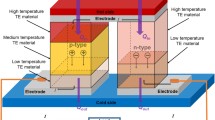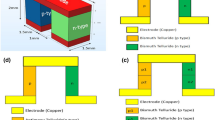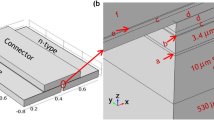Abstract
The thermal implication of peel stresses and Joule and Thomson heating on the delamination of photovoltaic-thermoelectric generator (PV-TEG) layers is modelled and established numerically. The scope of the study embraces simulation of the hybrid system with and without electric potential difference. Furthermore, the results obtained from the interfacial peel stresses demonstrate that uneven contractions occur in the layers of the hybrid system, resulting in delamination. In addition, the conductor strip/TEG interface has the highest peel stress with a numerical value of 0.13 GPa, while the glass/ethyl vinyl acetate (EVA) interface presents a contrasting stress pattern in comparison to the EVA/cell, EVA/back plate and conductor strip/TEG interface. However, the n-type leg of the TEG has a higher thermal stress in comparison to the entire system components resulting from the application of 7 mV electric potential. Finally, this paper demonstrates that thermal stress is extremely deleterious in the TEG in comparison to the PV module. As a result, device failures will commence from the thermoelectric legs, with the n-type leg having a shorter operational life in comparison to the p-type leg.
Similar content being viewed by others
Abbreviations
- A pv :
-
PV surface area (m2)
- A x :
-
TEG variable cross-sectional area (m2)
- E :
-
Young's modulus (GPa)
- \( \vec{E} \) :
-
Electric field potential (V)
- G :
-
Incident irradiance (W/m2)
- h 0 :
-
Heat transfer coefficient (W/m2K)
- J :
-
Current density (A/m2)
- K :
-
Thermal conductivity (W/mK)
- Q h :
-
Hot junction heat (W)
- Qx, Qy, Qz :
-
Heat transfer component (W)
- R :
-
TEG electrical resistance (ohms)
- S :
-
Seebeck coefficient (V/K)
- S y :
-
Yield stress (GPa)
- T a :
-
Ambient temperature (K)
- T cell :
-
Cell temperature (K)
- T ref :
-
PV reference temperature (K)
- T sky :
-
Sky temperature (K)
- v :
-
Poisson ratio
- V :
-
Potential difference (V)
- w :
-
Wind speed (m/s)
- α :
-
Coefficient of thermal expansion (1/K)
- β 0 :
-
PV temperature coefficient (1/K)
- ρ :
-
Density (kg/m3)
- θ :
-
Tapered angle (°)
- \( \eta_{\text{pv}} \) :
-
PV efficiency
- \( \eta_{\text{ref}} \) :
-
PV reference efficiency
- σp, σn :
-
p and n-type electrical conductivity (S/m)
- σ1, σ2, σ3 :
-
Principal stresses (GPa)
- σ vm :
-
Von Mises stress (GPa)
- ε :
-
Strain
- \( U^{\prime\prime\prime} \) :
-
Internal heat generation (W/m3)
References
E. Skoplaki, A.G. Boudouvis, and J.A. Palyvos, Sol. Energy Mater. Sol. Cells 92, 1393 (2008).
S. Singh, O. Isreal, and R. Lamba, Sol. Energy 170, 896 (2018).
K. Kant, A. Shukla, A. Sharma, and P. Henry, Sol. Energy 140, 151 (2016).
J. Gao, Q. Du, X. Zhang, and X.-Q. Jiang, J. Electron. Mater. 40, 884 (2011).
Y. Lee, A.A.O. Tay, in PV Asia Pacific Conference (2013), pp. 265–271.
N. Barth, M. A. A. Khaleel, J. P. de M. Correia, and S. Ahzi, in MEMA (2015), pp. 441–450.
L. Yixian, A.A.O. Tay, in IEEE (2011), pp. 3172–3177.
J. Zaraket, M. Aillerie, and C. Salame, Energy Procedia 119, 702 (2017).
A.S. Al-Merbati, B.S.S. Yilbas, and A.Z.Z. Sahin, Appl. Therm. Eng. 50, 683 (2013).
T. Ming, W. Yang, Y. Wu, and Y. Xiang, Int. J. Hydrogen Energy 42, 3521 (2016).
S. Shittu, G. Li, X. Zhao, X. Ma, and Y. Golizadeh, Energy Convers. Manag. 184, 180 (2019).
Y. Wu, T. Ming, X. Li, T. Pan, K. Peng, and X. Luo, Energy Convers. Manag. 88, 915 (2014).
U. Erturun, K. Erermis, and K. Mossi, Appl. Therm. Eng. 73, 126 (2014).
H. Song, C. Gao, J. Li, P. Taylor, H. Song, C. Gao, and J. Li, J. Therm. Stress 38, 37 (2015).
J.N. Reddy and C.D. Chin, J. Therm. Stress 21, 593 (1998).
Z. Xue, Y. Yu, X. Li, and X. Tian, J. Therm. Stress 41, 80 (2018).
A.M. Khouri and M.A.O. Robles, Bringing Thermoelectricity into Reality, ed. P. Aranguren (London: IntechOpen, 2018), pp. 331–351.
R. Lamba and S.C. Kaushik, Energy Convers. Manag. 144, 388 (2017).
E.E. Antonova, D.C. Looman, in IEEE International Conference Thermoelectrics (2005), pp. 200–204.
O.I. Ibeagwu, P.M. Oko, U. Anuta, A.E. Kevwe, I.I. Ibe, J. Ifeanyi, C. Anyaoha, A. Kalu-Uka, E. Nwachukwu, in NIEEE Nsukka Chapter␣Conference (2019), pp. 338–348.
S. Shittu, G. Li, X. Zhao, X. Ma, Y. Golizadeh, and E. Ayodele, J. Power Sources 428, 53 (2019).
G. Li, X. Zhao, Y.I. Jin, X. Chen, J.I.E. Ji, and S. Shittu, J. Electron. Mater. 47, 5344 (2018).
R. Musii, N. Melnyk, and V. Dmytruk, J. Therm. Stress 41, 1125 (2018).
B.L. Wang and J.C. Han, Philos. Mag. Lett. 90, 241 (2010).
S. Ueda and Y. Tani, J. Therm. Stress 31, 403 (2008).
S. Ueda, M. Okada, and Y. Nakaue, J. Therm. Stress 41, 98 (2017).
Y. Ootao and Y. Tanigawa, Int. J. Mech. Sci. 47, 1769 (2005).
O.I. Ibeagwu, Energy 180, 90 (2019).
S. Mahmoudinezhad, A. Rezania, and L.A. Rosendahl, Energy Convers. Manag. 164, 443 (2018).
Author information
Authors and Affiliations
Corresponding author
Ethics declarations
Conflict of interest
The authors declare that they have no conflict of interest.
Additional information
Publisher's Note
Springer Nature remains neutral with regard to jurisdictional claims in published maps and institutional affiliations.
Rights and permissions
About this article
Cite this article
Maduabuchi, C.C., Mgbemene, C.A. & Ibeagwu, O.I. Thermally Induced Delamination of PV-TEG: Implication of Leg’s Joule and Thomson Heating. J. Electron. Mater. 49, 6417–6427 (2020). https://doi.org/10.1007/s11664-020-08390-6
Received:
Accepted:
Published:
Issue Date:
DOI: https://doi.org/10.1007/s11664-020-08390-6




